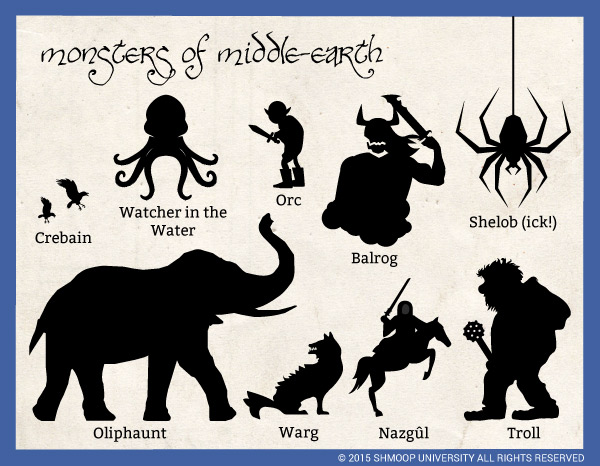Character Analysis
All the book’s descriptions of the Balrog (and the CGI that we get in Peter Jackson’s version of The Fellowship of the Ring) make him sound basically like your stereotypical demon or devil. The Balrog is a huge shadow. In the middle of the shadow is the shape of a fierce-looking man. The Balrog seems at home with flame; in fact, in its right hand, it carries a blade "like a stabbing tongue of fire" (2.5.80). In its left hand, it carries a whip.
This creature comes to fight the Company as they attempt to flee through Moria. Gandalf warns them, "Fly! This is a foe beyond any of you" (2.5.83). Gandalf stands in the middle of the bridge of Khazad-dûm and refuses to allow the Balrog to pass. He breaks the bridge on which both he and the Balrog stand and the Balrog falls into the darkness. With its whip, it catches Gandalf around the ankle and he falls, too.

(Click the infographic to download.)
The scene of Gandalf's death is a bit like Obi-wan Kenobi's demise in Star Wars: the old mentor always has to die pretty early in the movie so that the young hero (Luke Skywalker or, in this case, Frodo Baggins) can start to stand on his own two feet. If Gandalf were to keep leading the Fellowship, he might make the way too easy for Frodo. So he has to die to let Frodo go his own way. The Balrog is the force that makes Gandalf's disappearance possible.
Just to remind us that it wasn't just anything that overcame Gandalf, Legolas tells the Company that the Balrog of Morgoth is "of all Elf-banes the most deadly, save the One who sits in the Dark Tower" (2.7.24). Gimli adds that the Balrog haunts the Dwarves' darkest dreams; they call it Durin's Bane, since it rose during the reign of Durin VI to destroy Khazad-dûm.